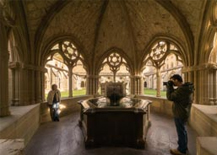
Locality: ABÁRZUZA (31178)
Address: Monasterio de Santa María de Iranzu
Zone: The Central Zone
Website: www.monasterio-iranzu.com
Style: Romanesque
Centuries of construction: XII
Telephones: 948520047 – 948520012
Email: monasterio@monasterio-iranzu.com
Description
Hidden in the lush green valley of Yerri, in an isolated spot between the mountains, stands the Monastery of St. Mary of Iranzu, a grandiose Cistercian abbey built between the twelfth and fourteenth centuries.
Its elegant, austere Gothic cloister is one of the most beautiful corners of the monastery, inviting you to discover the different parts of the complex, which was renovated in 1942.
A delightful atmosphere of peace and serenity soothes the spirit and invites one to enter a state of reflection throughout the monastery. Do not miss the opportunity to have a quiet chat with the Teatine fathers, the living essence of the monastery, or to sit in silence beside the fountain in the cloister.
The environment
After your visit, enjoy the glorious natural surroundings of a semi-wild valley with its springs of crystalline water, and stroll along the track that goes up the gully created by the river Iranzu at the foot of the Andía range of mountains.
Very close to Estella, three kilometres from Abárzuza between the green valleys that make up the Yerri mountains, stands the monastery of Iranzu. It perfectly fulfils the conditions established for its construction “? at the bottom of an enclosed valley, close to a river where the water flows abundantly and with the sky as a horizon, in order to be closer to God”.
The monastery
The Cistercian monks established the monastery in 1176 and although they were protected by the Carlists during the Desamortización (confiscation of church property) of 1835 they had to abandon it in 1839 when it became the property of the State.
The building remained empty until 1942 when its reconstruction started, and a year later the Teatine fathers settled in Iranzu. They are the current inhabitants of the monastery, although it had traditionally been Benedictine.
The entrance gives direct access to the Gothic section, built between the twelfth and fourteenth centuries, which explains the variety of styles from the half-point galleries from the earliest part to the pointed arches with interior trefoils and bull’s eyes in elaborate tracery from the full Gothic period. From the cloister, which still houses a Gothic washstand with an original hexagonal fountain, you can access most of the rooms of the monastery.
Guided visit
This is where the guided tour begins, which introduces you to the kitchen, in medieval style with a gigantic fireplace; the refectory, transformed in the 17th century; the pantry that served as a storeroom; the abbot’s residence, restored in the Baroque period; the punishment cells, in which the monks and converts paid for their sins on a diet of bread and water; the capitular hall, built at the end of the twelfth century, which is still in its original state; and the church of St. Mary, built at the end of the twelfth century. This church, in a Latin cross layout with one central and two side chapels, has a surprising amount of light due to the positioning of the windows.
Interpretation Centre
The monastery has an Interpretation Centre which is accessed from the cloister. Here you can find information on the monastery, its surroundings, and sights of interest in the area and the rest of Navarre. Although the monastery does not make things it does sell products under its own name, such as liqueurs, chocolates, caramelised almonds, honey, pastries, cheese, wine and ceramics, as well as books on the monastery and leaflets on the river Iranzu gully and other tourist itineraries.
Next to the monastery is a spacious picnic area from which various tracks lead off, such as the one that goes up the river Iranzu gully, an easy walk with some excellent views of the luxuriant holm oak woods and limestone outcrops that make up the area.







